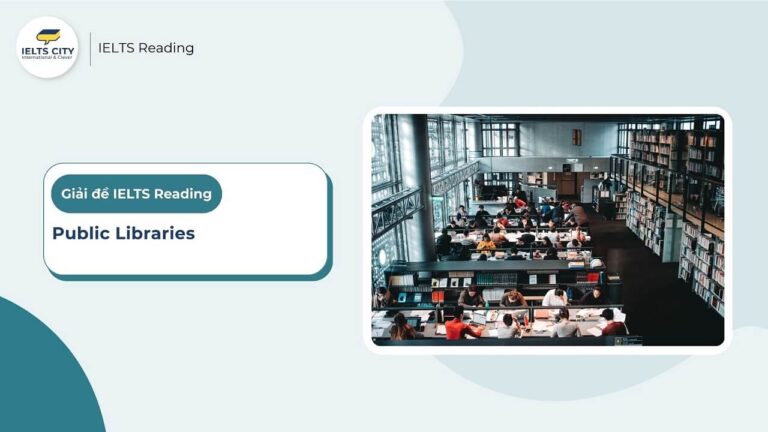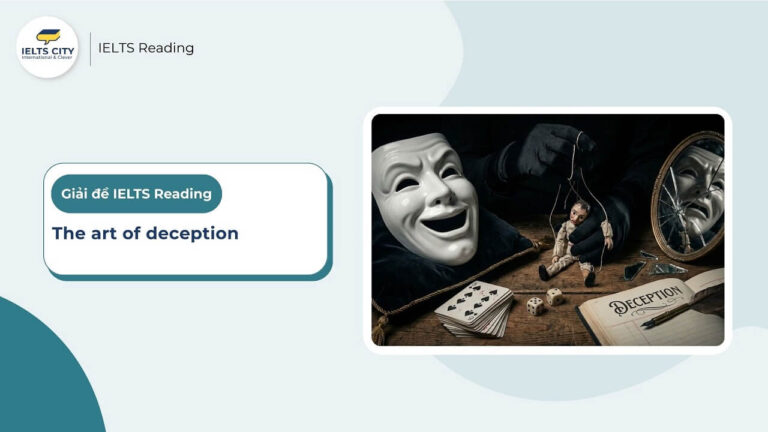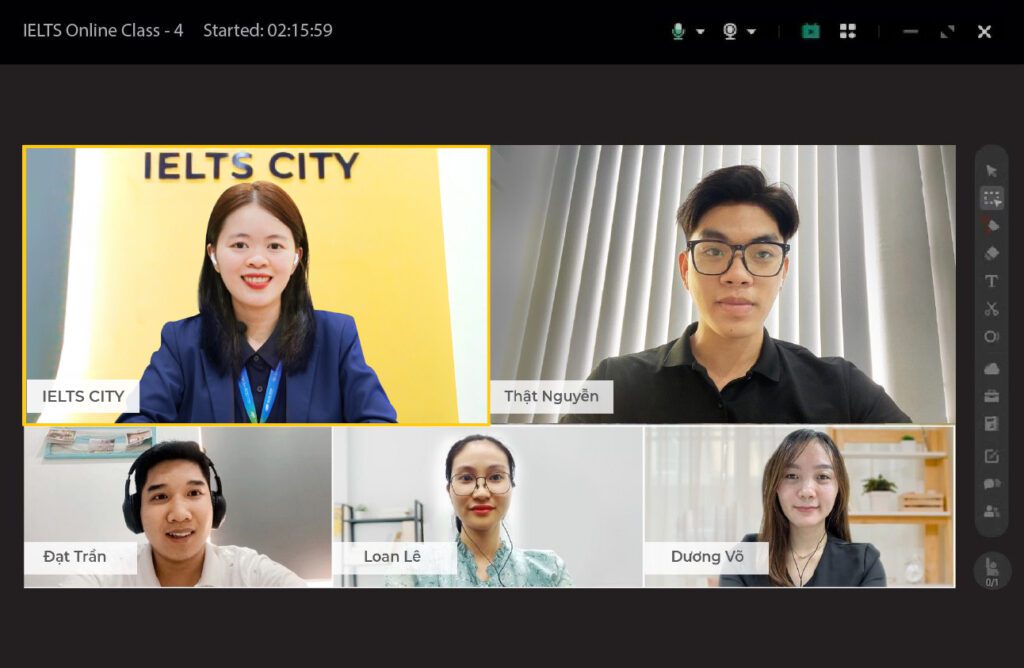Trong kỳ thi IELTS Reading, dạng bài Flow Chart Completion thuộc nhóm điền từ, yêu cầu thí sinh điền từ vào các chỗ trống trong một sơ đồ tóm tắt quá trình hoặc tiến trình các sự kiện diễn ra và hoàn thành chính xác các tóm tắt quy trình có trong bài viết.
IELTS CITY sẽ hướng dẫn bạn cách xử lý dạng bài dạng Flow Chart IELTS Reading này một cách hiệu quả, cũng như phân tích một ví dụ thực tế từ đề thi để bạn hiểu rõ hơn về cách làm bài nhé!

Nội dung chính
Toggle1. Flow Chart Completion là gì?
Flow Chart Completion là dạng bài IELTS Reading yêu cầu thí sinh điền một từ duy nhất từ bài đọc vào các chỗ trống trong sơ đồ. Sơ đồ này có thể là biểu đồ miêu tả một quá trình hoặc chuỗi sự kiện được sắp xếp theo thứ tự thời gian hoặc logic. Để hoàn thành dạng bài này, bạn cần tìm thông tin tương ứng với từng bước trong sơ đồ từ đoạn văn.
Dưới đây là ví dụ từ bài đọc The Dover Bronze-Age Boat, trích từ đề số 1, Cambridge Official Guide to IELTS.
2. Các bước làm dạng bài Flow Chart Completion trong IELTS Reading
Bây giờ IELTS CITY sẽ cùng các bạn làm bài ví dụ Flow Chart Completion phía trên với từng bước sau đây nhé!
Bước 1: Đọc kỹ yêu cầu đề bài
Cũng như nhiều dạng bài điền từ khác, điều đầu tiên bạn cần chú ý là đọc kỹ yêu cầu, đặc biệt là số lượng từ cho phép điền vào mỗi chỗ trống. Việc này giúp bạn tránh mắc lỗi do điền quá nhiều từ.
Trong ví dụ trên, bạn chỉ được phép điền một từ duy nhất (ONE WORD ONLY) từ bài đọc.
Bước 2: Phân tích biểu đồ và xác định các từ khóa trong sơ đồ
Tiếp theo, bạn cần xác định các từ khóa trong sơ đồ để tìm đúng đoạn văn chứa thông tin. Bạn có thể tìm kiếm đối tượng chính của biểu đồ, cùng với một số thông tin then chốt về thời gian, thứ tự xảy ra và sự kiện diễn ra trong quy trình đó.
Ví dụ, trong câu đầu tiên của sơ đồ, từ khóa là 1992 và construction, giúp bạn dễ dàng tìm đoạn văn nói về việc phát hiện con thuyền trong quá trình xây dựng (đoạn 1).
Bước 3: Đọc lướt để tìm kiếm thông tin và khoanh vùng các đoạn văn liên quan
Khi đã xác định được từ khóa, hãy đọc lướt bài đọc để tìm đoạn văn có chứa thông tin liên quan.
Trong ví dụ trên, điểm bắt đầu của quy trình này là 1992 và điểm kết thúc là 2012, vì thế chúng ta sẽ khoanh vùng các đoạn văn chứa những cột mốc này và nghiên cứu kỹ lưỡng.
Bước 4: Kết hợp các dữ kiện trong câu hỏi và các đoạn văn khoanh vùng để tìm từ cho các chỗ trống
Sau khi tìm được đoạn văn có chứa thông tin cần thiết, bạn cần chọn từ chính xác từ bài đọc và điền vào chỗ trống sao cho phù hợp với ngữ pháp và ngữ nghĩa của câu. Dưới đây là phân tích đáp án cho câu 1:
1992 – the boat was discovered during the construction of a ………….. 1992
Từ bước 3, chúng ta xác định được đoạn văn sau phù hợp với câu hỏi này:
It was 1992. In England, workmen were building a new road through the heart of Dover, to connect the ancient port and the Channel Tunnel, which, when it opened just two years later, was to be the first land link between Britain and Europe for over 10,000 years. A small team from the Canterbury Archaeological Trust (CAT) worked alongside the workmen, recording new discoveries brought to light by the machines.
Trong đoạn văn này, chúng ta thấy được từ đồng nghĩa hoặc parallel expression với construction là building, và của discovered là discoveries. Chúng ta cần tìm một thứ được xây dựng → một con đường (building a new road).
Bước 5: Kiểm tra lại đáp án
Cuối cùng, sau khi điền xong, hãy kiểm tra lại các từ đã điền để đảm bảo chúng phù hợp với yêu cầu về số từ, ngữ pháp và ngữ nghĩa.
Ở đây, các bạn cần đặc biệt cẩn thận, new road là một đáp án đúng về mặt ngữ nghĩa nhưng lại vi phạm yêu cầu đề bài, vì thế chúng ta phải bỏ new và đáp án cuối cùng sẽ là road.
3. Các lỗi thường gặp khi làm bài Flow Chart IELTS Reading
- Không tuân thủ giới hạn số từ: Một lỗi phổ biến là thí sinh điền quá số từ cho phép, dẫn đến đáp án bị sai dù đúng về mặt ý nghĩa.
- Chọn từ không chính xác: Một số thí sinh không lấy chính xác từ từ bài đọc, mà cố gắng diễn đạt lại, điều này dễ dẫn đến câu trả lời không đúng.
- Không đọc kỹ đoạn văn: Thí sinh có thể bỏ qua thông tin quan trọng hoặc đọc nhầm đoạn văn chứa từ khóa, dẫn đến việc điền sai đáp án.
4. Các tips làm bài Flow Chart IELTS Reading hiệu quả
- Đọc kỹ yêu cầu về số từ: Luôn chú ý đến yêu cầu về số từ trong đề bài để tránh mắc lỗi không đáng có.
- Tìm từ khóa chính: Xác định các từ khóa quan trọng trong sơ đồ và đoạn văn để tìm thông tin nhanh chóng.
- Sử dụng từ chính xác từ bài đọc: Hãy điền từ chính xác như trong bài đọc thay vì diễn đạt lại theo cách khác.
- Kiểm tra lại ngữ pháp và ngữ nghĩa: Đảm bảo rằng từ bạn điền phù hợp với cấu trúc ngữ pháp của câu và mang ý nghĩa đúng.
5. Bài tập Flow Chart IELTS Reading
Chúng ta hãy cùng nhau giải quyết phần còn lại của bài Flow-chart Completion trong bài đọc The Dover Bronze-Age Boat nhé.
THE DOVER BRONZE-AGE BOAT
It was 1992. In England, workmen were building a new road (Q1) through the heart of Dover, to connect the ancient port and the Channel Tunnel, which, when it opened just two years later, was to be the first land link between Britain and Europe for over 10,000 years. A small team from the Canterbury Archaeological Trust (CAT) worked alongside the workmen, recording new discoveries brought to light by the machines.
At the base of the deep shaft six meters below the modern streets, a wooden structure was revealed (Q10). Cleaning away the waterlogged site overlying the timbers, archaeologists realized its true nature. They had found a prehistoric boat, preserved by the type of sediment in which it was buried. It was then named the Dover Bronze-Age Boat.
About nine meters of the boat’s length was recovered; one end lay beyond the excavation and had to be left. What survived consisted essentially of four intricately carved oak planks: two on the bottom, joined along a central seam by a complicated system of wedges and stitched to the others. The seams had been made watertight by pads of moss (Q11), fixed by wedges and yew stitches.
The timbers that closed the recovered end of the boat had been removed in antiquity when it was abandoned, but much about its original shape could be deduced. There was also evidence for missing upper side planks. The boat was not a wreck, but had been deliberately discarded, dismantled and broken (Q6). Perhaps it had been “ritually killed” at the end of its life, like other Bronze-Age objects.
With hindsight, it was significant that the boat was found and studied by mainstream archaeologists who naturally focused on its cultural context (Q7). At the time, ancient boats were often considered only from a narrower technological perspective, but news about the Dover boat reached a broad audience. In 2002, on the tenth anniversary of the discovery, the Dover Bronze-Age Boat Trust hosted a conference (Q2), where this meeting of different traditions became apparent. Alongside technical papers about the boat, other speakers explored its social and economic contexts, and the religious perceptions of boats in Bronze- Age societies. Many speakers came from overseas, and debate about cultural connections was renewed.
Within seven years of excavation, the Dover boat had been conserved and displayed, but it was apparent that there were issues that could not be resolved simply by studying the old wood. Experimental archaeology seemed to be the solution: a boat reconstruction, half-scale or full- sized, would permit assessment of the different hypotheses regarding its build and the missing end. The possibility of returning to Dover to search for a boat’s unexcavated northern end was explored, but practical and financial difficulties were insurmountable – and there was no guarantee that the timbers had survived the previous decade in the changed environment (Q8).
Detailed proposals to reconstruct the boat were drawn up in 2004 (Q3). Archaeological evidence was beginning to suggest a Bronze- Age community straddling the Channel, brought together by the sea, rather than separated by it. In a region today divided by languages and borders, archaeologists had a duty to inform the general public about their common cultural heritage.
The boat project began in England but it was conceived from the start as a European collaboration. Reconstruction was only part of a scheme that would include a major exhibition and an extensive educational and outreach programme. Discussions began early in 2005 with archaeological bodies, universities and heritage organizations either side of the Channel. There was much enthusiasm and support, and an official launch of the project was held at an international seminar in France in 2007 (Q4). Financial support was confirmed in 2008 and the project then named BOAT 1550BC got under way in June 2011.
A small team began to make the boat at the start of 2012 on the Roman Lawn outside Dover museum. A full-scale reconstruction of a mid-section had been made in 1996, primarily to see how Bronze- Age replica tools performed. In 2012, however, the hull shape was at the centre of the work (Q12), so modern power tools were used to carve the oak planks, before turning to prehistoric tools for finishing. It was decided to make the replica haft-scale for reasons of cost and time (Q13), any synthetic materials were used for the stitching, owing to doubts about the scaling and tight timetable.
Meanwhile, the exhibition was being prepared ready for opening in July 2012 at the Castle Museum in Boulogne-sur-Mer (Q5). Entitled ‘Beyond the Horizon: Societies of the Channel & North Sea 3,500 years ago’ it brought together for the first time a remarkable collection of Bronze- Age objects, including many new discoveries for commercial archaeology and some of the great treasure of the past. The reconstructed boat, as a symbol of the maritime connections that bound together the communities either side of the Channel, was the centrepiece.
ĐÁP ÁN:
- road
Đoạn 1: It was 1992. In England, workmen were building a new road through the heart of Dover, to connect the ancient port and the Channel Tunnel, which, when it opened just two years later, was to be the first land link between Britain and Europe for over 10,000 years. A small team from the Canterbury Archaeological Trust (CAT) worked alongside the workmen, recording new discoveries brought to light by the machines.
→ Từ khóa: 1992, building, discoveries
- conference
Đoạn 5: In 2002, on the tenth anniversary of the discovery, the Dover Bronze-Age Boat Trust hosted a conference, where this meeting of different traditions became apparent.
→ Từ khóa: 2002, hosted
- proposals
Đoạn 7: Detailed proposals to reconstruct the boat were drawn up in 2004. Archaeological evidence was beginning to suggest a Bronze- Age community straddling the Channel, brought together by the sea, rather than separated by it.
→ Từ khóa: 2004, reconstruct, drawn up
- launch
Đoạn 8: There was much enthusiasm and support, and an official launch of the project was held at an international seminar in France in 2007.
→ Từ khóa: 2007, was held
- exhibition
Đoạn cuối: Meanwhile, the exhibition was being prepared ready for opening in July 2012 at the Castle Museum in Boulogne-sur-Mer. Entitled ‘Beyond the Horizon: Societies of the Channel & North Sea 3,500 years ago’ it brought together for the first time a remarkable collection of Bronze- Age objects, including many new discoveries for commercial archaeology and some of the great treasure of the past.
→ Từ khóa: 2012, a remarkable collection, objects
Vậy là chúng ta đã vừa tìm hiểu xong dạng bài Flow Chart IELTS Reading và tham khảo thêm một số bài tập hữu ích để hiểu rõ hơn về dạng đề này. IELTS CITY hy vọng với thông tin hữu ích mà trường chia sẻ, giúp bạn hiểu rõ hơn về cách làm dạng bài Flow Chart và chinh phục band điểm thật cao trong phần thi Đọc nhé!





















